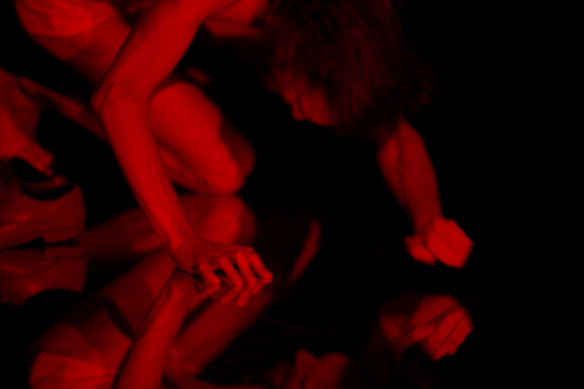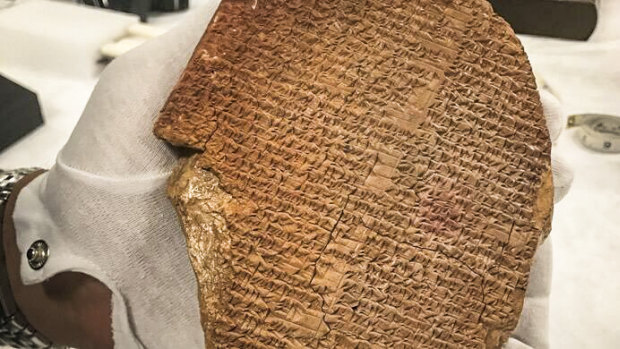
She unleashes her fury and Gilgamesh loses what he holds most dear, Enkidu. Through love, pain, desire and loss, the king eventually grasps his mortality and wisdom.

Gilgamesh is the original hero’s journey – about 1000 years older than the Odyssey and the Iliad.Credit:
Williams and Symonds are having something of a bromance of their own. This is their sixth Sydney Chamber Opera collaboration in an artistic partnership that began in 2011 with I Have Had Enough.
Since then, Williams has become the most prominent Australia director of his generation. As artistic director of the Sydney Theatre Company since 2016, his ground-breaking cine-theatre production of The Picture of Dorian Gray has garnered international attention and is Broadway-bound.
Williams will leave the STC at the end of the year. Whatever comes next, he is resolved to continue working with Symonds.
“I’ll direct Jack’s work for the rest of my life,” he says.
Staging this original hero’s journey – about 1000 years older than the Odyssey and the Iliad – has challenges. The narrative has a peculiar structure, multiple locations, and the two main characters are paradoxes. (They’re also giants). Gilgamesh is initially loathsome, while Enkidu – sent to rein in the king – soon displays a shocking capacity for cruelty.
“You have to hold the audience in that ever-evolving narrative and the unlikable quality of the central character at the beginning,” says Williams. “Enkidu, created to be the salvation to the tyranny of Gilgamesh, becomes corrupted. In order to be truly human, he becomes as corruptible as all humans have the propensity to be.”

A portion of the Epic of Gilgamesh.Credit: AP
The paradoxes are reflected in the music. “Jack has composed a chamber opera, but the sound of it will feel at times like a thousand instruments,” says Williams.
The rediscovery of the Epic of Gilgamesh is worthy of an opera itself. Lost for centuries, fragments of it were uncovered during excavations of ruined Nineveh (within Iraq’s present-day Mosul) in the mid-19th century. Written in an unknown angular script, cuneiform, the fragments were among 25,000 clay tablets shipped to the British Museum.
Little attention was paid until 1872, when a young self-taught scholar made a startling discovery. One Gilgamesh tablet told of a Babylonian Noah. Instructed to build a boat to save his family, birds and beasts, he survived the flood sent by the gods to destroy the Earth.
So excited was the scholar at his find – which appeared to corroborate the Biblical story – that he leapt up and ran about the room shedding his clothes. The discovery caused a sensation in Victorian England.
To anyone who has read the epic, the homoerotic element is evident in the relationship between Gilgamesh and Enkidu. The most tender and passionate relationship in the world’s oldest story is a same-sex one, and Symonds has expressed that in the music he wrote specifically for singers Jeremy Kleeman (Gilgamesh) and Mitchell Riley (Enkidu), which culminates in the forest scene.
‘I knew that I wanted them to unite on a single note - the middle point of both their colours.’
Composer Jack Symonds
“It builds towards them overtly loving each other in an unambiguous way,” he says. “It’s an opportunity for a moment of real connection before the rest of the piece plays out in a way that despoils that.
“I wanted to make something where the natural world and the blossoming of their love were one. I knew that I wanted them to unite on a single note - the middle point of both their colours. I built the entire scene backwards from that moment.”
Loading
It’s a novel way of working, but Symonds has long taken an innovative approach to creating contemporary opera. He composes with specific singers in mind. Indeed, he finds it difficult to compose otherwise. Symonds has worked previously, not just with Kleeman and Riley, but with all five singers in the production. As a result, he understands their vastly different voices and vocal colours.
“With traditional opera, there is an expectation that a role has a particular sound that everyone who does that role has to shoehorn themselves into (that role). That destroys the individuality of singers in an opera, in my view,” he says.
“The opposite is to make it entirely around the colours in every register. And knowing what a particular singer does in one note influences the way I write the other parts around it … I’ve tried to find the possibilities with a small but immensely virtuosic group of performers to make something entirely new.”
With librettist Louis Garrick, Symonds aimed to balance diverse elements of the complex tale in the first co-production between Sydney Chamber Opera, which the pair founded in 2010, and Opera Australia. Also involved are Ensemble Offspring and the Australian String Quartet, ensembles Symonds has composed for previously.
“We wanted to show its modernity but not rule out any of the strange and fantastical elements,” Symonds says. “What opera does well is take the things that make us human and find extraordinary ways of rendering that.”
Gilgamesh opens at Carriageworks on September 26.



























